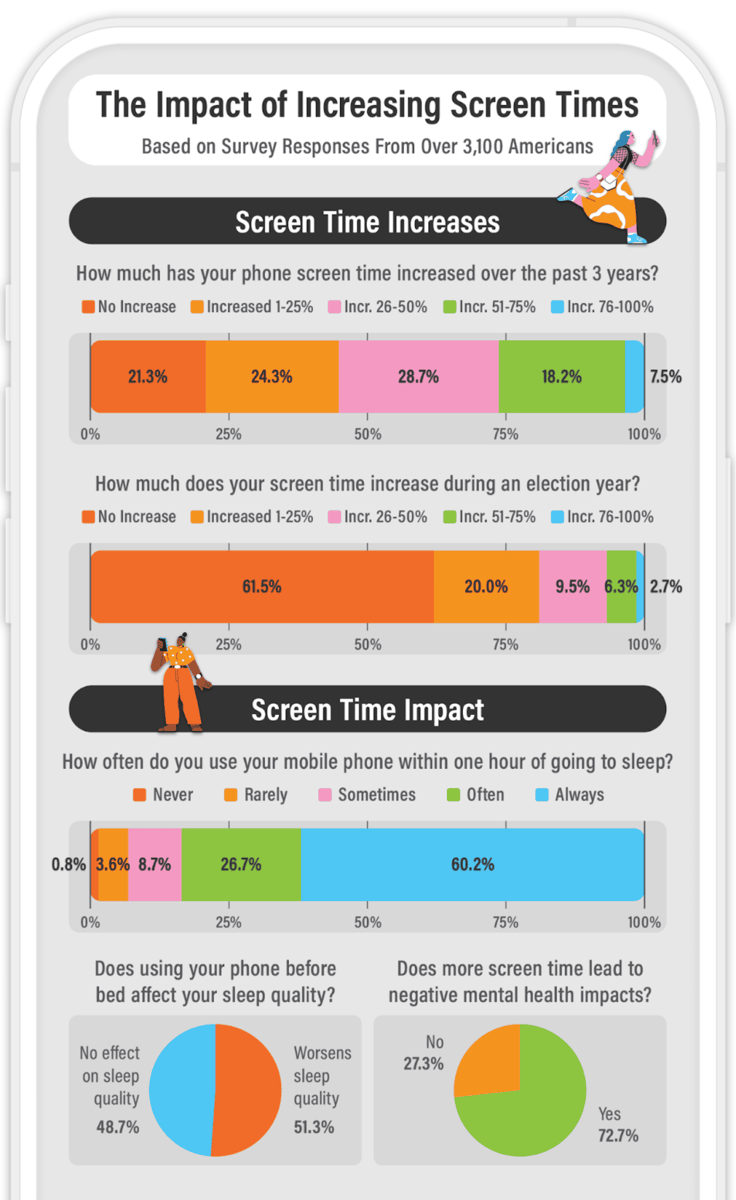
Mobile media consumption grew 460% from 2011 to 2021. In an era dominated by digital devices, understanding screen time habits is becoming increasingly important.
To shed light on this, we surveyed people across the U.S., asking them to access their most recent full-week screen time data to explore how much time Americans spend on their phones, which days see the highest screen time, and the apps and categories that dominate their usage.
We dive into key aspects of phone use, such as changes in screen time habits and the impact of significant events like election years. We also examined the mental health implications of excessive screen time and whether individuals are taking steps to manage their usage.
-
Navigate This Article:
Which States Have The Highest Average Screen Time?
We began our study in the only place it makes sense — putting a number on our addiction to our mobile devices. We asked residents from every state to access their phone settings and tell us their average daily screen time in the past week, the average number of times they picked their phones up, and the day of the week they had the most screen time.
Click through the map below to view detailed screen time breakdowns in your state.
Nationally, Americans average about 6 hours and 35 minutes of screen time per day and pick up their phones approximately 108 times, which means an average of only about 4 minutes per pick-up.
Notably, Sunday is the day that the average American spends the most time on their phone.
Let’s take a look at states on the extremes.
States That Spend the Most Time on Their Phones
One interesting regional trend we noticed was the prevalence of Southwestern states among those who spend the most time on their phones.
- Arizona: 8 hours, 50 minutes
- Washington: 8 hours, 17 minutes
- Kentucky: 8 hours, 3 minutes
- Missouri: 7 hours, 49 minutes
- New Mexico and Texas: 7 hours, 20 minutes
Arizona, New Mexico, and Texas all feature in the top six for mobile screen time with Arizona outpacing every other state by a full half hour.
States That Spend the Least Time on Their Phones
Only seven states average less than six hours of screen time per day, and only two of those average less than five and a half hours — Kansas and Maine.
- Kansas: 5 hours, 27 minutes
- Maine: 5 hours, 28 minutes
- Nebraska: 5 hours, 43 minutes
- Minnesota: 5 hours, 48 minutes
- Massachusetts: 5 hours, 49 minutes
Screen time doesn’t tell the whole story of how glued Americans are to their phones. Mobile devices serve multiple purposes, from calling and texting to gaming and streaming, often diverting time from other screens. An even more telling indicator of phone addiction is the number of times people compulsively pick up their phones throughout the day.
The variable pickups during the day, set against relatively consistent screen time, may indicate that those with fewer pickups are consuming more long-form content on their mobile devices. This trend is likely to continue as things like streaming TV and movies on the go become more popular.
“Despite the fact that the likes of Apple and Google have made efforts in the past few years to build better screen-time-tracking tools into their operating systems, the trends are clear — most Americans are using their phones more and more,” said HostingAdvice consumer technology expert, Christian de Looper. “This isn’t all that surprising. After all, social media apps like TikTok and Instagram are highly addictive and incentivized to keep users in-app as much as possible.”
States That Pick Their Phones Up the Most
North Carolinians are the biggest culprits of grabbing their phones as, on average, they pick them up 10 more times per day than any other state.
- North Carolina: 129 pick-ups per day
- Utah: 119 pick-ups per day
- California: 119 pick-ups per day
- Nevada: 117 pick-ups per day
- Tennessee: 116 pick-ups per day
Western states including Utah, California, and Nevada, are also grabbing for their phone at a rate much higher than other states in the country.
States That Pick Their Phones Up the Least
Conversely, states like Maine are more comfortable without their phone in their palm. The Pine Tree State is the only one that appears in both the states that spend the least amount of time on their phones and the states that pick up their phones least often.
- Maine: 92 pick-ups per day
- Idaho: 93 pick-ups per day
- West Virginia: 95 pick-ups per day
- New Hampshire: 96 pick-ups per day
- Oklahoma: 96 pick-ups per day
These insights tell a story of regional variations in screen time and phone use. Southwestern states lead in daily phone usage, while those in the West are more likely to pick theirs up more often during the day. Understanding these trends can help shed light on digital consumption patterns and their potential impacts on daily life.
How Much Is Screen Time Impacting Americans?
We also wanted to explore how mobile screen time has changed for Americans over the years. We asked respondents about its impact on their daily habits, sleep, and mental health and considered the steps people are taking to reduce their screen time.

Mobile Phone Use:
- Social Media: 73% of Americans primarily use their phones for social media.
- Watching Videos: 49% spend significant time watching videos.
- Reading News: 28% use their phones to read news.
- Work-Related Activities: 22% engage in work-related tasks on their phones.
Screen Time Increases:
- About one-fourth of Americans report that their screen time has increased by more than 50% over the past three years.
- 1 in 5 Americans say their screen time increases by more than 25% during an election year.
- 44% of Americans note that increased mobile phone use has reduced their time spent on other devices.
Impact on Sleeping:
- 60% of Americans “always” use their mobile phone within one hour of going to bed. This behavior is more prevalent among Gen Zers (73%) compared to Baby Boomers (38%).
- 51% believe that using their mobile phone before bed affects their sleep quality.
- 73% of Americans believe that increased phone screen time negatively impacts their mental health. For Gen Z, this concern is even higher at 84%, while only 41% of Baby Boomers agree.
Steps to Change:
- Only 17% of Americans use apps or phone settings to monitor or limit their screen time. Among Gen Z, this figure rises to 25%, compared to just 9% of Baby Boomers.
- 14% have made changes to their screen time habits due to its impact on sleep and health, with an additional 29% considering making changes.
The way Americans use mobile phones has changed dramatically over the years. From a quick way to communicate to a content hub that offers endless hours of entertainment, mobile phones are now central to daily life for millions. Social media, video streaming, news consumption, and even work-related tasks dominate phone usage. This shift has led to a significant increase in screen time over the past three years.
Being constantly connected comes with its own set of challenges. Many Americans acknowledge the negative impacts on their sleep and mental health, with over half believing their bedtime phone usage affects their sleep quality. Despite these concerns, only a small fraction are taking active steps to limit their screen time.
Closing Thoughts
As mobile phones continue to evolve in an attempt to make our lives easier, understanding and managing their lasting impact on the individual becomes increasingly important. While some see their screen time as a necessary part of modern life, others are more concerned about its impacts on sleep and mental health.
Despite the growing awareness of these issues, only a minority are actively taking steps to reduce their usage.
“These trends are somewhat worrisome, especially given the clear impacts on mental health, and unfortunately, there doesn’t seem to be much of an end in sight. That said, hopefully, as more data about screen time and the impacts of social media on mental health continue to be released, a generation of phone-addicted parents can raise a generation of children with better habits around the apps they use and how often they use those apps,” said Christian.
As technology continues to shape our lives, staying informed is crucial. At HostingAdvice, we provide the latest advice and guidance on all things tech-related, helping you navigate the digital landscape with confidence. Whether you’re looking to optimize your screen time or stay updated on tech trends, we’re here to support your journey.
Methodology
To determine what screen time looks like in the U.S. in 2024, we surveyed more than 3,100 Americans over two weeks in May 2024 to find out how much time they spent on their phones, how often they picked them up, the day they used their phones the most, and other ways screen time affects their day to day.
To collect the state screen time data, we had survey respondents access their phone settings and report exactly what their screen time stats were for the past week. The additional insights come from a random sample of an additional 1,000 Americans with mobile phones.



